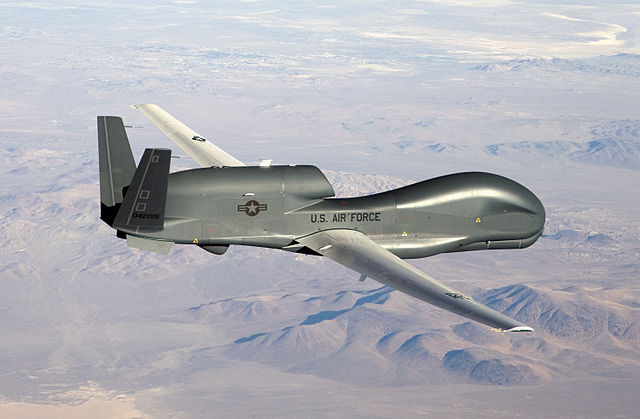With the war in Afghanistan winding down and the pressure against federal spending increasing, the Pentagon is reconfiguring itself for leaner peacetime operations and unmanned aerial vehicles (UAVs) are among the programs being affected.
With the war in Afghanistan winding down and the pressure against federal spending increasing, the Pentagon is reconfiguring itself for leaner peacetime operations and unmanned aerial vehicles (UAVs) are among the programs being affected.
Defense Secretary Chuck Hagel on Monday (February 24, 2014) outlined some of the cuts to be proposed when the White House presents its fiscal year 2015 budget to Congress on March 4. Even though the Bipartisan Budget Act signed into law at the end of December eased sequestration limits for this fiscal year and next, he said, the final number on the Pentagon’s FY2014 budget was $31 billion below what the president had requested. Moreover, he pointed out, DOD spending will be capped in FY15 at roughly $496 billion, a level some “$45 billion less than was projected in the president’s budget request last year.”
The fiscal realities mean a shrinking of manpower and more base closures. Some programs will be slowed while others, including the A-10 Warthog attack jet and the U-2 spy plane, will be cut entirely.
The GPS/INS-guided Global Hawk unmanned aircraft will replace the U-2, Hagel said, a decision he described as “a close call. ”
Defense managers had previously recommended retaining the U-2 and divesting the Global Hawk Block 30, saying the U-2 was sufficient to meet what was expected to be a reduced need for high altitude intelligence, surveillance, and reconnaissance. Part of the reason, said a senior defense official, was that it would have required a “significant, long-term investment in Global Hawk to improve its sensor capabilities to U-2 parity.”
Cost/Benefit Analysis
But the Department of Defense (DoD) was able to reduce the Global Hawk’s operating costs and “with its greater range and endurance,” said Hagel, “the Global Hawk makes a better high-altitude reconnaissance platform for the future.”
“Last year, we judged (Global Hawk) wasn’t going to save us enough money to be the replacement for (the U-2),” explained the defense official, “but since then, the operating costs have come down significantly, and the opportunities for the technology on the Global Hawk Block 30 have gone up, and our ability to afford them, to train with the operation and support costs has looked more attractive.
“We can’t afford them both,” another official said during a background budget briefing for reporters. “We have to pick one or the other, and that’s a key point here. So, if we can’t afford them both, and the Global Hawk Block 30 can do the job, we’re going with that.”
Other UAVs Fare Less Well
The Pentagon will scale back its use of other unmanned systems, however, including slowing plans to expand the number of around-the-clock combat air patrols flying GPS-guided Predator and Reaper aircraft. Instead of building up to 65 patrols the service will limit itself to 55 while retaining the ability to surge to 71 CAPs if necessary.
Each CAP consists of four aircraft and operates with approximately 168 people. A CAP is staffed with pilots, sensor operators, and mission intelligence coordinators as well as maintenance, launch and recovery personnel, and the experts to process, exploit, and disseminate the intelligence gathered every mission.
Although it’s dialing back on the number of patrols, DoD will upgrade some of the UAVs they use. The Air Force will keep buying the more capable Reapers, said Hagel, until it has “an all-Reaper fleet.”
The Reaper is larger and more powerful than the Predator and is primarily used as an intelligence-collection asset. It can also be used to destroy or disable time-sensitive targets with persistence and precision. General Atomics Aeronautical Systems, Inc., builds both aircraft.
Cost is not the only reason to limit the number of patrols, said Hagel. While “effective against insurgents and terrorists,” he said, they “cannot operate in the face of enemy aircraft and modern air defenses.”
“The one thing we’re really going to be doing in my estimation, in the next decade or so, is probably trying to build some more stealthy platforms like the U class and attack capable UASs (unmanned aerial systems) that are stealthy,” said Mike Blades, a senior industry analyst at Frost & Sullivan.
“Right now we have control of the air. We had control of the air over Iraq. We had control of the air over Afghanistan,” Blades added. “We’re not going to have that in the future. We’re going to have to have something that can get in and out stealthfully. Anti-access/area denial is a big catch phrase right now. We’re going to have to worry about getting our systems into a contested area and out of a contested area without losing them — and right now we don’t have systems that can do that.”
Those kinds of concerns could lead to UASs with defensive capabilities, according to a September 2013 Frost and Sullivan presentation, “U.S. DoD Unmanned Aerial Systems Market,” and could see the Air Force move to pair UASs with manned aircraft for protection in a technique called manned-unmanned teaming, or MUM-T.
Expanding unmanned systems — stealthy, paired, or otherwise — could be off the table, however, if sequestration reemerges in 2016.
If Congress does not agree to end sequestration, the cuts will be deeper and faster, said Hagel. The Air Force would have to retire the Global Hawk Block 40 fleet and sustain 10 fewer Predator and Reaper 24-hour combat air patrols. They would also have to take deep cuts to flying hours, he said, which would prevent a return to adequate readiness levels.






